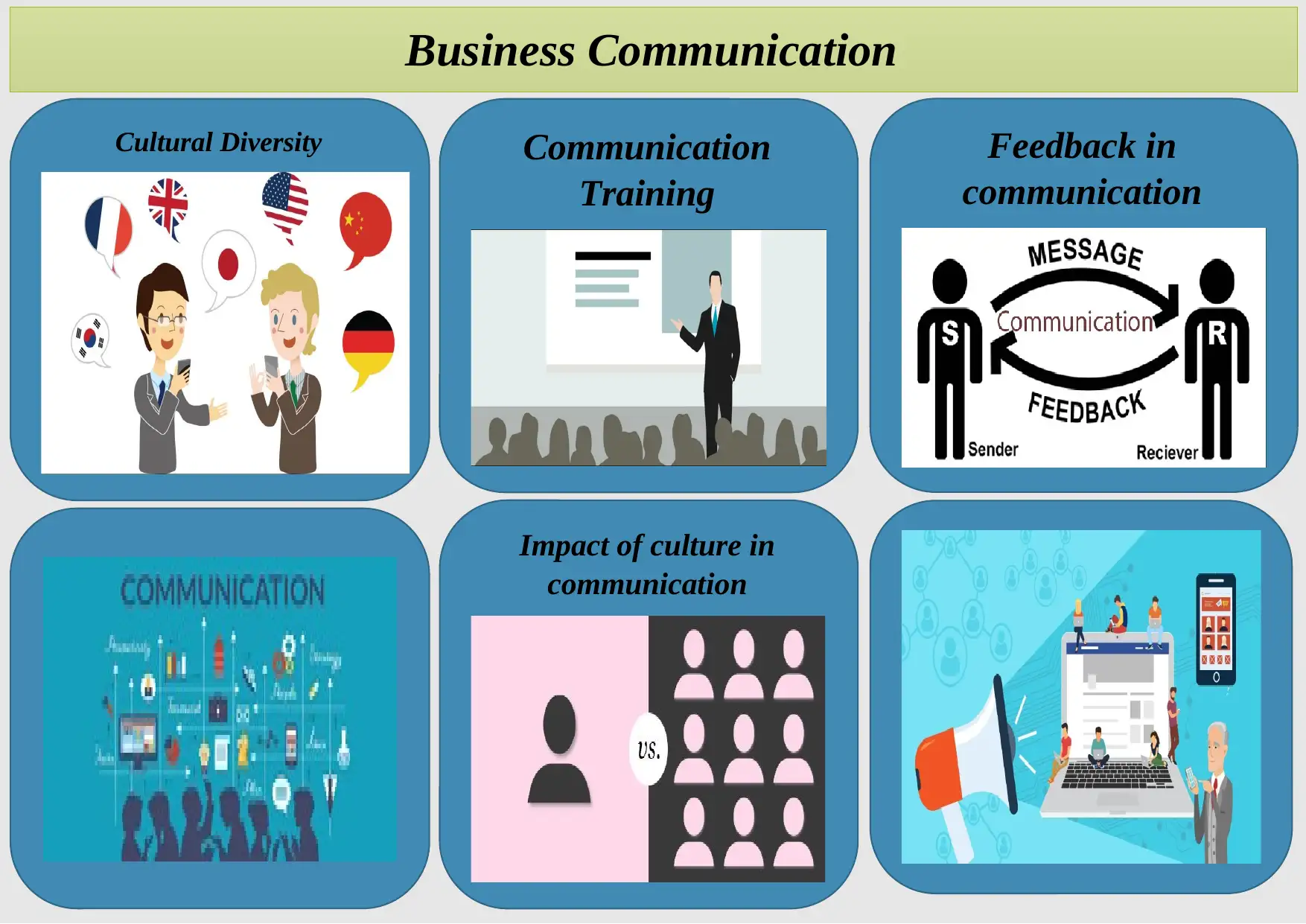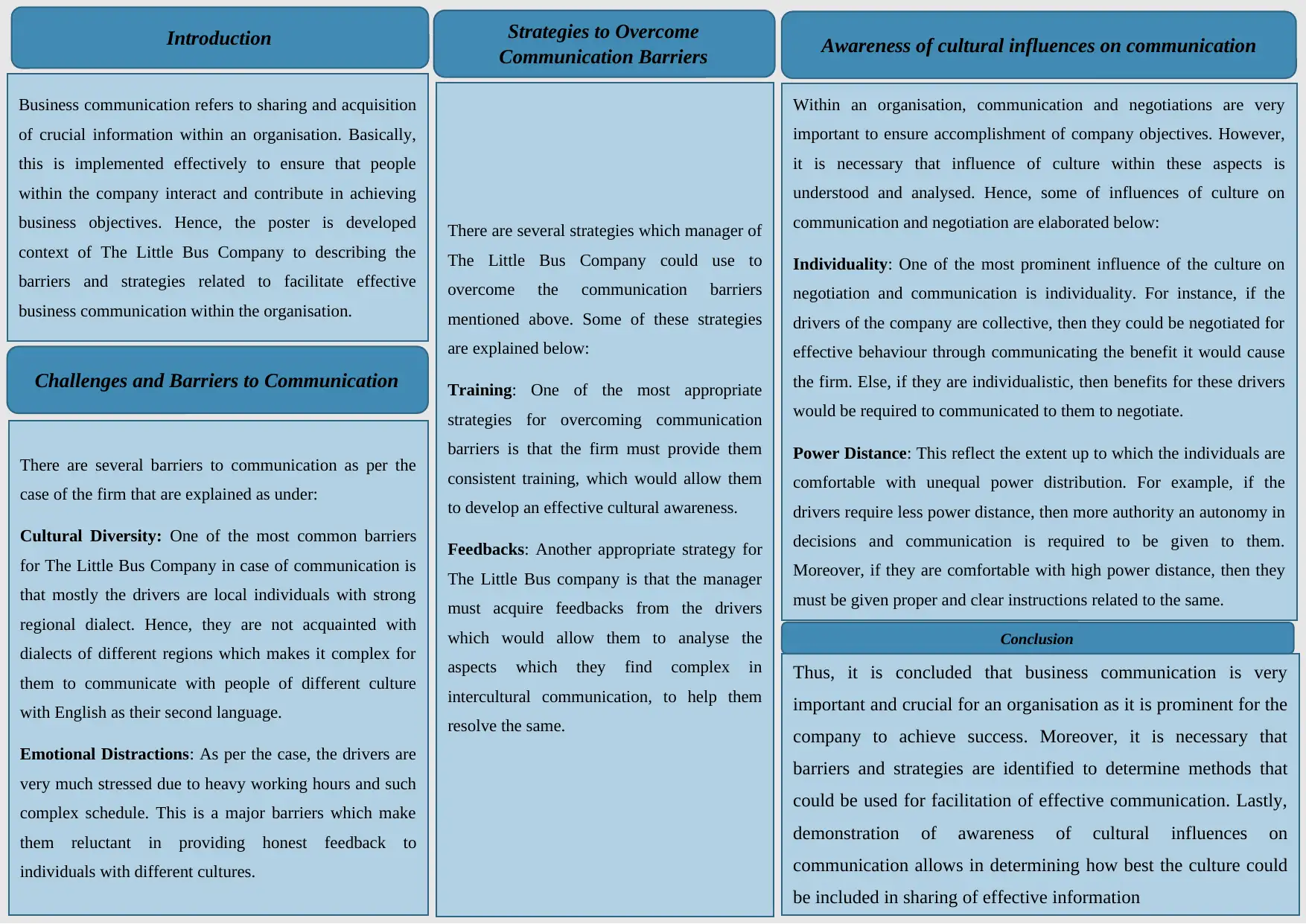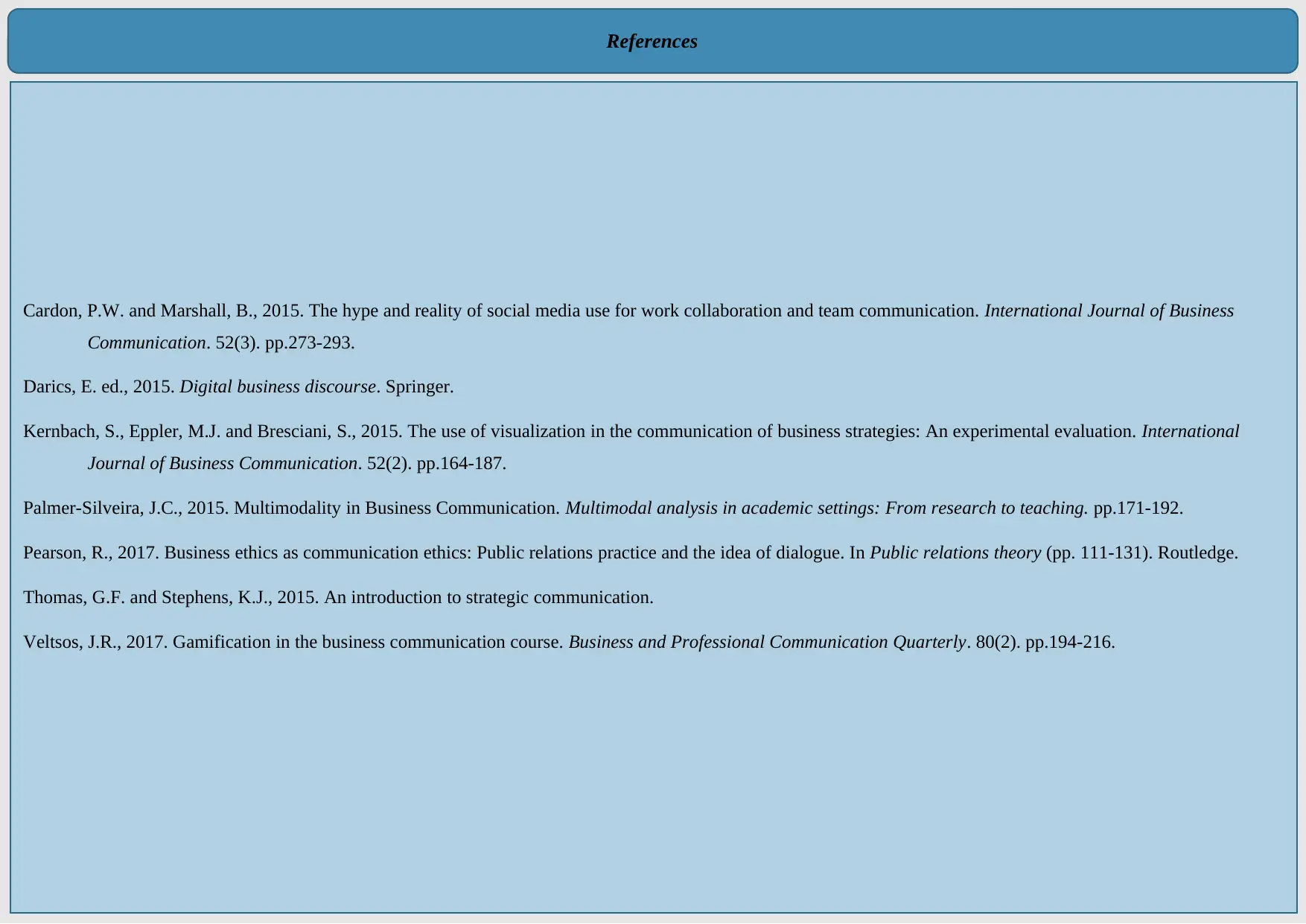Impact of Cultural Diversity on Business Communication Report
VerifiedAdded on 2023/01/13
|4
|785
|2
Report
AI Summary
This report delves into the critical aspects of business communication, emphasizing the impact of cultural diversity within an organization, particularly in the context of The Little Bus Company. It identifies key communication barriers, such as regional dialects and heavy workloads, and explores how cultural influences like individuality and power distance affect communication and negotiation. The report proposes strategies to overcome these barriers, including providing consistent training to enhance cultural awareness and implementing feedback mechanisms to understand and address communication complexities. It underscores the significance of understanding cultural influences in fostering effective business communication, ultimately contributing to the achievement of organizational goals. The report also includes a comprehensive list of references.

Business Communication
Communication
Training
Impact of culture in
communication
Cultural Diversity Feedback in
communication
Communication
Training
Impact of culture in
communication
Cultural Diversity Feedback in
communication
Paraphrase This Document
Need a fresh take? Get an instant paraphrase of this document with our AI Paraphraser


Introduction
Business communication refers to sharing and acquisition
of crucial information within an organisation. Basically,
this is implemented effectively to ensure that people
within the company interact and contribute in achieving
business objectives. Hence, the poster is developed
context of The Little Bus Company to describing the
barriers and strategies related to facilitate effective
business communication within the organisation.
Challenges and Barriers to Communication
Strategies to Overcome
Communication Barriers
There are several strategies which manager of
The Little Bus Company could use to
overcome the communication barriers
mentioned above. Some of these strategies
are explained below:
Training: One of the most appropriate
strategies for overcoming communication
barriers is that the firm must provide them
consistent training, which would allow them
to develop an effective cultural awareness.
Feedbacks: Another appropriate strategy for
The Little Bus company is that the manager
must acquire feedbacks from the drivers
which would allow them to analyse the
aspects which they find complex in
intercultural communication, to help them
resolve the same.
There are several barriers to communication as per the
case of the firm that are explained as under:
Cultural Diversity: One of the most common barriers
for The Little Bus Company in case of communication is
that mostly the drivers are local individuals with strong
regional dialect. Hence, they are not acquainted with
dialects of different regions which makes it complex for
them to communicate with people of different culture
with English as their second language.
Emotional Distractions: As per the case, the drivers are
very much stressed due to heavy working hours and such
complex schedule. This is a major barriers which make
them reluctant in providing honest feedback to
individuals with different cultures.
Within an organisation, communication and negotiations are very
important to ensure accomplishment of company objectives. However,
it is necessary that influence of culture within these aspects is
understood and analysed. Hence, some of influences of culture on
communication and negotiation are elaborated below:
Individuality: One of the most prominent influence of the culture on
negotiation and communication is individuality. For instance, if the
drivers of the company are collective, then they could be negotiated for
effective behaviour through communicating the benefit it would cause
the firm. Else, if they are individualistic, then benefits for these drivers
would be required to communicated to them to negotiate.
Power Distance: This reflect the extent up to which the individuals are
comfortable with unequal power distribution. For example, if the
drivers require less power distance, then more authority an autonomy in
decisions and communication is required to be given to them.
Moreover, if they are comfortable with high power distance, then they
must be given proper and clear instructions related to the same.
Awareness of cultural influences on communication
Thus, it is concluded that business communication is very
important and crucial for an organisation as it is prominent for the
company to achieve success. Moreover, it is necessary that
barriers and strategies are identified to determine methods that
could be used for facilitation of effective communication. Lastly,
demonstration of awareness of cultural influences on
communication allows in determining how best the culture could
be included in sharing of effective information
Conclusion
Business communication refers to sharing and acquisition
of crucial information within an organisation. Basically,
this is implemented effectively to ensure that people
within the company interact and contribute in achieving
business objectives. Hence, the poster is developed
context of The Little Bus Company to describing the
barriers and strategies related to facilitate effective
business communication within the organisation.
Challenges and Barriers to Communication
Strategies to Overcome
Communication Barriers
There are several strategies which manager of
The Little Bus Company could use to
overcome the communication barriers
mentioned above. Some of these strategies
are explained below:
Training: One of the most appropriate
strategies for overcoming communication
barriers is that the firm must provide them
consistent training, which would allow them
to develop an effective cultural awareness.
Feedbacks: Another appropriate strategy for
The Little Bus company is that the manager
must acquire feedbacks from the drivers
which would allow them to analyse the
aspects which they find complex in
intercultural communication, to help them
resolve the same.
There are several barriers to communication as per the
case of the firm that are explained as under:
Cultural Diversity: One of the most common barriers
for The Little Bus Company in case of communication is
that mostly the drivers are local individuals with strong
regional dialect. Hence, they are not acquainted with
dialects of different regions which makes it complex for
them to communicate with people of different culture
with English as their second language.
Emotional Distractions: As per the case, the drivers are
very much stressed due to heavy working hours and such
complex schedule. This is a major barriers which make
them reluctant in providing honest feedback to
individuals with different cultures.
Within an organisation, communication and negotiations are very
important to ensure accomplishment of company objectives. However,
it is necessary that influence of culture within these aspects is
understood and analysed. Hence, some of influences of culture on
communication and negotiation are elaborated below:
Individuality: One of the most prominent influence of the culture on
negotiation and communication is individuality. For instance, if the
drivers of the company are collective, then they could be negotiated for
effective behaviour through communicating the benefit it would cause
the firm. Else, if they are individualistic, then benefits for these drivers
would be required to communicated to them to negotiate.
Power Distance: This reflect the extent up to which the individuals are
comfortable with unequal power distribution. For example, if the
drivers require less power distance, then more authority an autonomy in
decisions and communication is required to be given to them.
Moreover, if they are comfortable with high power distance, then they
must be given proper and clear instructions related to the same.
Awareness of cultural influences on communication
Thus, it is concluded that business communication is very
important and crucial for an organisation as it is prominent for the
company to achieve success. Moreover, it is necessary that
barriers and strategies are identified to determine methods that
could be used for facilitation of effective communication. Lastly,
demonstration of awareness of cultural influences on
communication allows in determining how best the culture could
be included in sharing of effective information
Conclusion
⊘ This is a preview!⊘
Do you want full access?
Subscribe today to unlock all pages.

Trusted by 1+ million students worldwide

References
Cardon, P.W. and Marshall, B., 2015. The hype and reality of social media use for work collaboration and team communication. International Journal of Business
Communication. 52(3). pp.273-293.
Darics, E. ed., 2015. Digital business discourse. Springer.
Kernbach, S., Eppler, M.J. and Bresciani, S., 2015. The use of visualization in the communication of business strategies: An experimental evaluation. International
Journal of Business Communication. 52(2). pp.164-187.
Palmer-Silveira, J.C., 2015. Multimodality in Business Communication. Multimodal analysis in academic settings: From research to teaching. pp.171-192.
Pearson, R., 2017. Business ethics as communication ethics: Public relations practice and the idea of dialogue. In Public relations theory (pp. 111-131). Routledge.
Thomas, G.F. and Stephens, K.J., 2015. An introduction to strategic communication.
Veltsos, J.R., 2017. Gamification in the business communication course. Business and Professional Communication Quarterly. 80(2). pp.194-216.
Cardon, P.W. and Marshall, B., 2015. The hype and reality of social media use for work collaboration and team communication. International Journal of Business
Communication. 52(3). pp.273-293.
Darics, E. ed., 2015. Digital business discourse. Springer.
Kernbach, S., Eppler, M.J. and Bresciani, S., 2015. The use of visualization in the communication of business strategies: An experimental evaluation. International
Journal of Business Communication. 52(2). pp.164-187.
Palmer-Silveira, J.C., 2015. Multimodality in Business Communication. Multimodal analysis in academic settings: From research to teaching. pp.171-192.
Pearson, R., 2017. Business ethics as communication ethics: Public relations practice and the idea of dialogue. In Public relations theory (pp. 111-131). Routledge.
Thomas, G.F. and Stephens, K.J., 2015. An introduction to strategic communication.
Veltsos, J.R., 2017. Gamification in the business communication course. Business and Professional Communication Quarterly. 80(2). pp.194-216.
1 out of 4
Related Documents
Your All-in-One AI-Powered Toolkit for Academic Success.
+13062052269
info@desklib.com
Available 24*7 on WhatsApp / Email
![[object Object]](/_next/static/media/star-bottom.7253800d.svg)
Unlock your academic potential
Copyright © 2020–2025 A2Z Services. All Rights Reserved. Developed and managed by ZUCOL.





